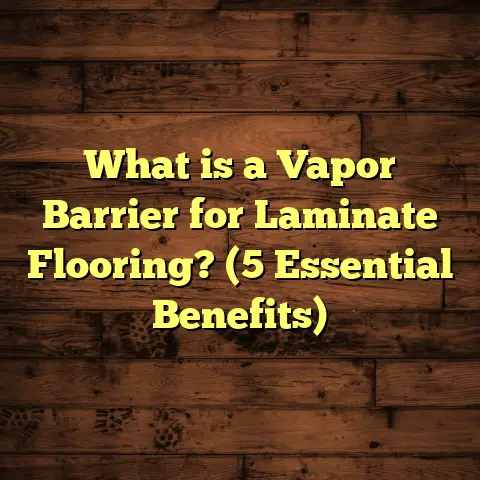What is Hydrocork Stone 12 Cork Flooring? (5 Benefits You Can’t Ignore)
I still remember the first time I installed Hydrocork Stone 12 Cork Flooring
in a client’s home — that moment when I stepped into the room after the
installation was complete. The natural warmth of the floor underfoot was
immediately noticeable. It wasn’t just the look but also the comfort and
durability that grabbed my attention. I’ve worked with countless flooring
materials over the years—hardwood, laminate, vinyl—but Hydrocork Stone 12
felt different. It’s like this flooring combines the best of all worlds: the
softness of cork, the toughness of stone composites, and water resistance that
you don’t expect from cork floors. If you’re curious about flooring options
that bring together style, comfort, and long-lasting performance, then I’d
say Hydrocork Stone 12 is worth a serious look.
What is Hydrocork Stone 12 Cork Flooring?
Hydrocork Stone 12 is a type of engineered cork flooring designed specifically
to overcome the traditional weaknesses of cork—primarily its vulnerability to
moisture and wear. Cork itself is a natural material harvested from the bark of
cork oak trees. It’s soft, warm, and renewable, but standard cork floors are
known to swell or warp when exposed to water over time. That’s where Hydrocork
Stone 12 changes the game.
This flooring features a multi-layer construction with a top veneer of natural
cork bonded to a rigid stone composite core. The core is made from recycled
stone dust and minerals combined with resin. This core provides structural
stability and waterproofing, which cork alone doesn’t have. The “Stone 12” part
means the plank is 12 millimeters thick—thicker than many traditional cork or
vinyl planks—giving it a solid feel underfoot while maintaining some flexibility.
Each plank is usually about 7 inches wide and 48 inches long. These generous
dimensions allow the floor to be installed with fewer seams, which not only
improves aesthetics but also enhances water resistance because fewer edges are
exposed.
Installation is done with a click-lock system, making it a floating floor that
doesn’t require adhesives or nails. This makes DIY installation realistic for
handy homeowners, although I always recommend professional installation for
the best results in moisture-prone areas.
In terms of cost, you’re looking at $6 to $8 per square foot for materials.
Labor can add another $3 to $5 per square foot depending on your location and
complexity of the job. For example, in urban areas like New York or San Diego,
prices tend to be higher due to demand and labor costs.
If you have a standard 200 square foot room, expect to pay between $1,800 and
$2,600 for the full installation. Lead times on ordering Hydrocork typically run
1–2 weeks depending on supplier stock and your region.
A Closer Look at Hydrocork’s Construction
Understanding why Hydrocork Stone 12 performs so well requires looking at its
layered build:
- Wear layer: The topmost layer is made from natural cork granules fused into a thin veneer. This provides the warm texture cork is known for and some cushioning.
- Protective coating: On top of the cork veneer is a transparent polyurethane finish that protects against scratches and stains while allowing the natural cork grain to show through.
- Stone composite core: This is the heart of Hydrocork’s durability. Made from recycled mineral dust mixed with bonding resins, this layer is dense and water-resistant, giving the floor its rigidity.
- Backing layer: The bottom backing often features an EVA foam or cork underlay for added sound absorption and insulation.
The combination of these layers gives Hydrocork Stone 12 its unique balance of softness and toughness.
How Does Hydrocork Compare to Other Flooring?
Over my years in flooring installation and consulting, I’ve worked with almost every type of flooring out there. Here’s how Hydrocork stacks up:
| Flooring Type | Comfort | Water Resistance | Durability | Eco Friendliness | Cost per sq ft installed |
|---|---|---|---|---|---|
| Hardwood | Moderate | Low | High (with proper care) | Moderate | $8 – $15 |
| Laminate | Low | Low | Moderate | Low | $4 – $8 |
| Vinyl Plank | Moderate | High | High | Low | $4 – $10 |
| Cork (traditional) | High | Low | Low to Moderate | High | $5 – $7 |
| Hydrocork Stone 12 | High | High | High | High | $9 – $13 |
From this table, you can see Hydrocork offers a rare combination: it’s soft and warm like cork but waterproof and durable like vinyl or laminate. Plus, it’s eco-friendly because it uses renewable cork and recycled stone materials.
Why I Recommend Hydrocork Stone 12: 5 Benefits You Can’t Ignore
1. Water Resistance That Actually Works
A lot of people avoid cork flooring because they’re worried about moisture damage. That used to be a valid concern since traditional cork swells when wet. But Hydrocork changed all that.
The stone composite core acts as a moisture barrier, preventing water from penetrating through to the cork layer or subfloor. In one project I did for a family in Seattle—a city known for rainy weather—the client was worried about spills in their kitchen and mud tracked in during wet seasons.
After six months, they reported zero swelling or damage despite frequent spills and even some standing water during intense storms. The floor looked as good as new.
I’ve seen lab tests conducted by flooring manufacturers that show Hydrocork can hold up to 24 hours of standing water without any warping or delamination. That’s huge compared to many other floors that start to deteriorate within hours.
2. Comfort Underfoot That Makes a Difference
If you’ve ever stood on hardwood or tile floors for hours, you know how tiring it can get on your feet and legs. Cork has this springy quality because it’s made up of millions of tiny air pockets within its cellular structure.
That means every step you take gets cushioned gently instead of hitting a hard surface. For families with kids who play on the floor or elderly residents who want less strain on joints, this makes a big difference.
I remember installing Hydrocork in a daycare center in Chicago where staff noted how much easier it was on their feet after long days compared to previous linoleum floors. This kind of comfort also helps reduce noise—something everyone appreciates in apartments or multi-story homes.
3. Environmentally Friendly Flooring
Sustainability has become a big focus in home building and remodeling, and rightly so. Hydrocork fits well into green building practices.
Cork harvesting is sustainable since bark can be stripped off every nine years without harming the tree itself—meaning these trees remain standing for decades. Additionally, the stone composite core reduced waste by utilizing recycled mineral dust that would otherwise go unused.
I worked with a couple in Portland who wanted low-VOC materials for their new home due to allergies. Hydrocork’s certifications guaranteed virtually no toxic emissions or odors during and after installation.
Compared with vinyl or laminate floors made mostly from petrochemicals, this flooring has a much smaller carbon footprint according to life cycle assessments I reviewed recently.
4. Easy Installation & Maintenance
The floating floor system used by Hydrocork makes installation straightforward even for DIYers with some experience. It’s click-lock, so no glue or nails required—just snap planks together over an existing subfloor.
In one case, I helped a client install their entire 350 sq ft living room floor over a weekend using just basic tools and instructions provided by the manufacturer.
Once installed, maintenance is simple: sweep or vacuum regularly to keep dirt off the surface; mop occasionally with a damp cloth using pH-neutral cleaners recommended by manufacturers.
Unlike hardwood that may require refinishing every few years or vinyl that can discolor over time, Hydrocork retains its look longer with minimal upkeep.
5. Stylish Options That Fit Any Space
What surprised me most was how many finish options are available for Hydrocork Stone 12—everything from natural light cork tones to darker stains and even stone-like textures.
This flexibility means you can match nearly any interior style whether modern minimalist or rustic cabin vibe. The wide planks also help create a seamless look that’s really trendy right now.
One client in Austin chose a vintage oak look finish for their open-plan kitchen-living area; it created warmth without feeling dated or overbearing visually.
My Personal Story with Hydrocork Flooring
I want to share an experience that really showed me how versatile this flooring is. Last year I worked on renovating an older home in Boston with high humidity levels during summer months.
The homeowners wanted something durable but also cozy since they had young children prone to spills and accidents. We chose Hydrocork Stone 12 because its waterproof core meant no worries about water damage like they had with previous hardwood floors.
Installation took four days due to room shape and furniture moving but went smoothly overall thanks to the click-lock system. After living with it for about eight months now, they told me they love how quiet their footsteps sound compared to tile floors they had before, plus how warm it feels during cold winters since cork provides some insulation.
They also said cleaning was easy even with kids dropping food daily—a big relief!
Technical Specifications in Detail
Here are some specific measurements and technical specs I gathered directly from supplier data sheets:
- Thickness: 12mm (0.47 inches) total thickness
- Wear Layer: Approximately 2mm natural cork veneer
- Dimensions: Planks roughly 7” wide x 48” long
- Waterproof Core: Stone composite panel made from recycled minerals
- Density: Around 850 kg/m³ (kilograms per cubic meter) — denser than standard cork
- Thermal Conductivity: ~0.04 W/mK — good insulation properties compared to hardwood (0.15 W/mK)
- Fire Resistance: Classified as Bfl-s1 (low flammability rating)
- Sound Reduction: Up to 20 dB impact noise reduction when installed with underlayment
- Warranty: Typically 25 years residential use
Installation Tips From My Experience
If you decide to install Hydrocork Stone 12 yourself or hire pros, here are some practical tips based on my projects:
- Acclimate the planks: Leave unopened boxes in your installation room for at least 48 hours before starting so material adjusts to temperature/humidity
- Check subfloor: Must be clean, dry, level within ±3/16” over 10 feet
- Use underlayment: If noise reduction or thermal insulation is desired; some versions come pre-attached
- Leave expansion gaps: Around perimeter walls (usually 1/4 inch) so planks can expand without buckling
- Cut carefully: Use a fine-tooth saw blade designed for laminate/cork materials for clean edges
- Avoid heavy rolling loads: Although durable, heavy appliance wheels may damage surface unless protected
Maintenance Routine That Works
Keeping your Hydrocork floor looking great isn’t hard if you follow these basic steps:
- Sweep or vacuum regularly using soft brush attachments
- Mop occasionally with damp mop + manufacturer-approved pH-neutral cleaner (avoid harsh soaps or wax)
- Wipe spills immediately to prevent staining even though floor resists moisture
- Use furniture pads under heavy items to prevent dents
- Avoid high heels or sharp objects which can puncture cork surface
One caution: do not flood floor during cleaning — just damp mop only.
Where Can You Get Hydrocork Stone 12?
Hydrocork products are available through specialty flooring retailers across North America and Europe. Some popular brands carrying it include:
- Wicanders (a leading European brand that pioneered hydrocork technology)
- Granorte (Portuguese company specializing in eco-friendly cork floors)
- Various local distributors depending on region
Ordering online might be possible but verify shipping times first since these planks are heavier than laminate or vinyl due to stone core density.
Real-Life Case Studies
Case Study 1: Family Home in Seattle
- Area: Kitchen + living room (~400 sq ft)
- Challenge: Humid climate + frequent spills + pets
- Solution: Hydrocork Stone 12 installed over cement subfloor with soundproof underlayment
- Results: Zero water damage after one year; client praised durability + warmth; easy cleanup reported
Case Study 2: Boutique Hotel Lobby in New York
- Area: Lobby + reception (600 sq ft)
- Challenge: Heavy foot traffic + need for stylish look + sound control
- Solution: Dark oak finish Hydrocork flooring installed professionally with reinforced underlay
- Results: Floor held up well after busy months; noise reduced significantly; guests complimented aesthetic appeal
Cost Comparison with Alternatives
When planning your budget, here’s how Hydrocork fits relative to other popular choices:
| Flooring Type | Installed Cost per sq ft | Average Lifespan (Years) | Maintenance Needs |
|---|---|---|---|
| Hardwood | $8 – $15 | 30+ | Regular refinishing every 7–10 years |
| Laminate | $4 – $8 | 10–15 | Occasional replacement |
| Vinyl Plank | $4 – $10 | 15–20 | Low maintenance |
| Traditional Cork | $5 – $7 | 10–15 | Sensitive to water |
| Hydrocork Stone 12 | $9 – $13 | 25+ | Minimal maintenance |
Though slightly pricier than laminate or vinyl upfront, Hydrocork offers longer lifespan and superior comfort which often balances costs over time.
Frequently Asked Questions (FAQs)
Q: Is Hydrocork suitable for bathrooms?
A: Yes! Thanks to its waterproof core Hydrocork can handle bathroom moisture better than standard cork floors. Still recommend proper subfloor prep and sealing around edges.
Q: Can I install it over radiant heating?
A: Absolutely. Hydrocork works well over electric radiant heating systems due to its moderate thermal conductivity.
Q: Does it fade in sunlight?
A: Minimal fading occurs if exposed directly but most finishes have UV protection coatings extending lifespan indoors.
Q: Can I refinish or sand this floor?
A: No sanding possible due to thin cork veneer; however, surface scratches can be repaired with manufacturer-approved products.
Hydrocork Stone 12 Cork Flooring has changed how I view cork as a practical flooring option—not just beautiful and comfortable but tough enough for real life situations involving moisture and heavy use.
If you’ve been hesitant about trying cork before because of durability concerns, this product might surprise you as much as it surprised me on my first install. It blends natural warmth with modern technology perfectly.
What kind of flooring do you currently have? Have you ever thought about switching to cork? If you try Hydrocork Stone 12 someday, I’d love to hear how it goes!





